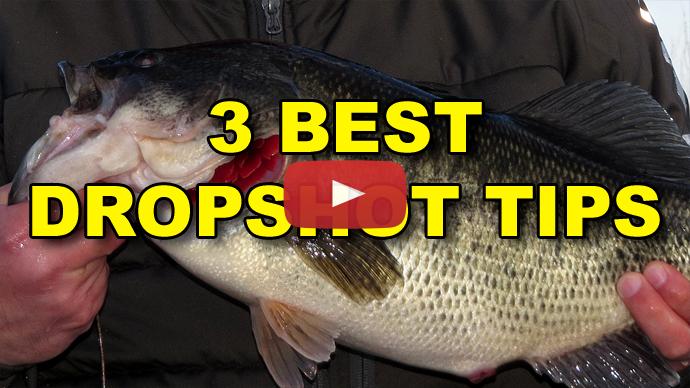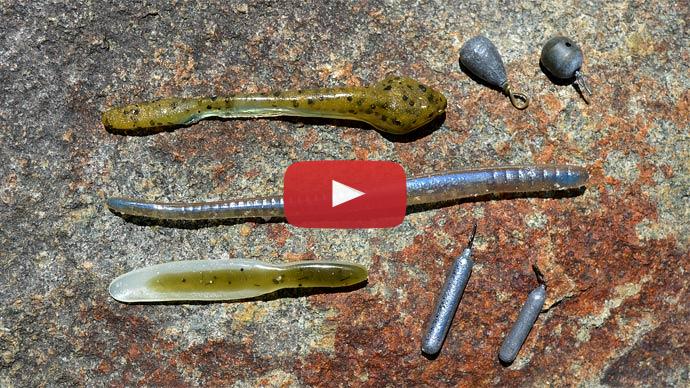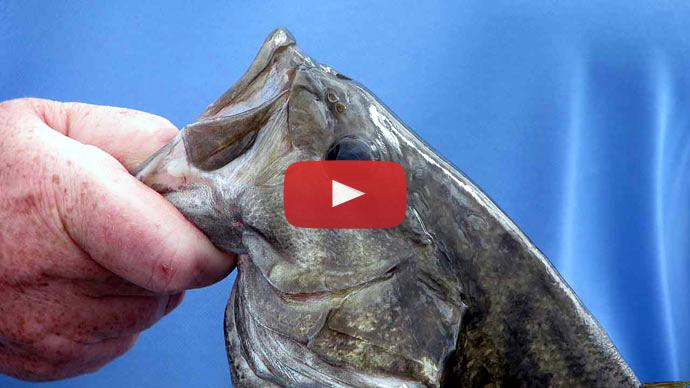Glenn: Oh, oh, oh. Here we go.
Keri: Yay. Right off that habitat.
Man: That's a decent fish.
Carol: Yes, Keri.
Keri: Oh, you little turd! Don’t jump!
Carol: We'll go slow.
Keri: Easy does it, big guy. He's as mad as piss and vinegar. He's pissed.
Carol: Nice largemouth.
Keri: Right off that habitat.
Carol: And I fish that habitat a while.
Keri: He just came right off that habitat. Come here. You're the one who ate it, don't get mad at me. That's a little guy but bigger than anything I've caught all day.
Carol: Yes, exactly.
Keri: Got you right in the roof of the mouth, right where I'm supposed to. He is pissed off at me.
Glenn: You probably got the biggest one of the day so far.
Keri: Little guy, but you're cute. Thank you for playing. Right off the habitat. Oh, he's quick. He wasn't playing with you.
Glenn: Hey, folks, Glenn May here with BassResource.com and today, let's talk about drop shotting in the summer. What is the best time to use a drop shot and where to fish it and how to fish it in the summertime to catch more bass? So, that's what we're talking about today.
Before I get too much into that, I wanna talk about the rod and reel and how we're using this. I'm not gonna get too much into it because I've got a whole nother video that talks about how to rig it. I got that link down here at the bottom. You can take a look at that but essentially it's spinning gear.
We're using super-light line because the light line enables that bait to act naturally in the water. I'm using fluorocarbon line without any leaders because fluorocarbon allows that bait to move and flex naturally. Braid has a little bit of buoyancy to it. It's also a stiffer line. It doesn't let that bait move and flex as much as I'd like to, so I'm using straight fluorocarbon line, light line, spinning outfit. That's what you need to use. I've got it on a VMC SpinShot hook. Looks like that. That allows the bait to move freely because it spins, right? Plus, it eliminates line twists on your line. So, that's how I use my drop shot. More information on that can be found on the link below.
But let's talk about how to fish it in the summertime and where to fish it. In the summertime, bass are scattered. Yep, there's a lot that are deep but there's also a lot of fish that are up shallow as well. So, the way I like to fish this drop shot, in particular, is I use it to target the deeper fish. The ones that are in on the off-shore structure. And I do this particularly when the fish are in a neutral, the negative feeding mode and I know they're set up shop on that kinda structure.
It's not a search bait. There's other baits and techniques for that that work much better but a drop shot, when those fish aren't willing to bite but you know they're sitting on those points. You know they're on that rock pile. They're just not willing to bite. That's when you break this out. This little puppy here.
I'm using a finesse worm today, not much action. Sometimes I'll use a minnow-sized bait to mimic that, but really you want something that doesn't have a whole lot of action. Maybe a tube will work as well. Tubes don't have a whole lot of action as well. Something like that because it's a real slow, methodical way of fishing in an area, picking it apart. When the fish aren't chasing down bait, you don't want something with a whole lot of action to it. So, this is just a four-inch hand-poured finesse worm.
Carol: Wow.
Glenn: Here we go. Nice little smallie.
Carol: Oh, that's a nice one. Yes, we're just talking about smallmouth.
Glenn: There we go.
Carol: Cool. That's just a nice, healthy little fish there.
Glenn: Come here, you.
Carol: Does he know how to lip them?
Glenn: Oh, come on, now. Really?
Carol: I was gonna offer to do it for you.
Glenn: Thanks.
Carol: That's a little potty...potbelly on him.
Glenn: Yeah, this guy's got a little belly on him.
Carol: There is a fish and he's even in a place that looked good.
Glenn: Aaron’s Magic, of course.
Carol: Was it really?
Glenn: Yeah.
Carol: That's not Aaron’s Magic.
Glenn: A little football.
Carol: That's Peoples.
Glenn: Oh, Peoples? Okay, sorry. All right. No, he took off nice and slow.
Keri: He knew he had a camera.
Glenn: What you do is I'm fishing main lake points. I'm fishing humps, rock piles, drop-offs, inside bends of creek channels, the inside corners of that where you might find maybe a stump field or chunk rock, that kinda cover. That's where I'm fishing. Anywhere from 10 feet or deeper. That's when I break this out when these fish are just lethargic and hanging out relating to that kind of stuff.
What I'll do is I take this, the way to fish it is you just cast it out there to that cover and when it falls, watch that line very carefully because a lot of times, those fish are relating near that cover. They see something falling down to them, they'll come up out of that cover and boom, smack it. And you're letting it fall on slackline, you're not gonna feel that bite. So, you have to see it. To do that, watch that line carefully. You're gonna watch it jump, twitch, move off to the side. Sometimes it'll just speed up. It'll just start spooling off really quickly, that's because the fish has grabbed it and he's swimming away with it. So, it just changes speed and the rate of fall. Those subtle things signal a fish has bit it and you better set the hook. Just a light pull back. It's not a hard set because you got an exposed hook. But that's how you catch a lot of those fish.
But if it reaches all the way to the bottom and a fish hasn't bit it yet, then reel down to it. And you want a nice, tight line. Straight-line connection to it. And you don't wanna reel it, don't wanna move it. You just wanna let it sit there and hold it steady. Now what's gonna happen is you may think that the bait's just laying there limp, but actually it's not because a couple of things.
First of all, you can't hold your rod that steady for a long period of time. You're not a statue. So, the rod's moving a little bit and it's gonna cause vibrations to be transmitted down the line to the bait. In addition, little waves are coming up and they're lapping against the line. Just subtle movements, but something's ticking on that line. It's gonna cause those vibrations to be transmitted to that bait. In addition, as much as you wanna hold still, if you're in a boat, for example, you're still gonna be moving around a little bit. And this weight here, this little weight is gonna be dragging on that bottom, moving a little bit. And it's gonna be bumping along. And it'll cause that bait to move. Just a little bit of movement is all's it takes.
Carol: Yes, yes.
Glenn: There we go.
Carol: A finale. It's a large-mouth. It's a finale. Look at the rock right here.
Keri: It’s fighting like it weighs, like, 18 pounds.
Glenn: I know. He's...
Carol: It's a finale, though. Look at this.
Glenn: All right. Come here, you.
Carol: Good for you.
Glenn: Spin, spin, spin. You're not a big one, but...
Carol: No, it's a nice one. It's not a dink.
Glenn: I'll take it. That works.
Carol: That's a finale fish.
Glenn: Now, after a while, you've just sat there like that. Now give it a little bit of a twitch. Just all you're doing, you're just giving a little twitch with your hand like this. And all's you wanna do is move that line, okay? Just bounce the line. You're gonna feel that line bounce. You might be looking at the rod tip. The rod tip's moving just a little bit like that, okay? But really all you're doing...look at this bait. I'm doing the same exact motion but look how much it's moving. Look how much it's dancing. Okay? I was barely moving it. But it's dancing around. Now in the water, of course, it's not gonna dance that much because it's in water. But the point is, it's going to make the bait look more lively. Look a little more action.
And that's all you need, so you don't need to bounce it up and down and shake it and do all this, impart all this action. It's very subtle. You're just...you're sitting around in a spot, again, you know the fish are relating to this cover already. You're just enticing them to bite. So, you don't need to move it that much. You just need to get them to notice it. That's the point. So, moving that, just a little bit. That's all you gotta do.
So, if that doesn't work, then what I like to do is I'll lift the bait up and I'll reposition on the piece of structure, let it settle back down, and start all over again. Go through the same paces that I just mentioned. And keep working that structure really hard.
Bass will tend to school up in the summertime. So, if you catch one off that piece of structure, you're gonna catch more. So, stick on that structure working methodically and you're gonna catch a lot of fish this way. I hope that helps. For more tips and tricks like this, visit BassResource.com.



